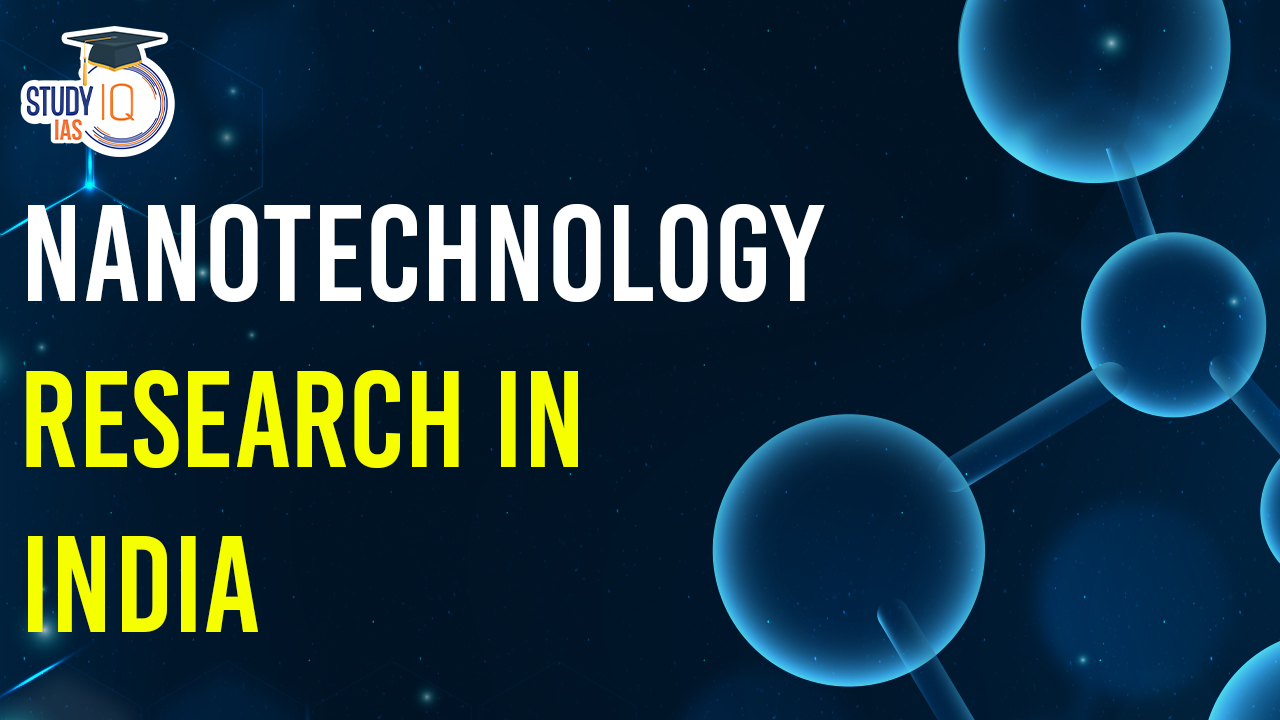Table of Contents
Nanotechnology research in India began in 2001 with the NanoScience and Technology Initiative (NSTI), funded with Rs. 60 crores. The 2007-launched Nano Mission, backed by Rs. 1,000 crores, aimed to boost basic nanotechnology research and infrastructure. The Nanotechnology Initiatives Division focuses on electronics manufacturing, emphasizing nanoelectronics research and world-class fabrication facilities. Examples include Rite Water’s filtration systems for water treatment and NanoBlue, purifying up to 50,000 liters daily, showcasing India’s commitment to leveraging nanotechnology for societal solutions and advancements.
We’re now on WhatsApp. Click to Join
Nanotechnology Research in India
Nanotechnology research in India commenced in 2001 with the establishment of the NanoScience and Technology Initiative (NSTI) under the Department of Science and Technology within the Ministry of Science. With an initial funding of Rs. 60 crores, NSTI was launched to build research infrastructure and foster basic research in the fields of nanoscience and nanotechnology.
In 2007, the Indian government took a significant step by initiating the Nano Mission, a 5-year program allocated with a budget of Rs. 1,000 crores. The primary objectives of the Nano Mission were to promote fundamental nanotechnology research and enhance research infrastructure.
The Nanotechnology Initiatives Division has played a crucial role in shaping an ecosystem for electronics manufacturing in India. This initiative encompasses cutting-edge research in nanoelectronics, the development of innovative products and devices, and the establishment of world-class fabrication facilities.
Several noteworthy examples of nanotechnology applications in India include:
- Water Treatment: Rite Water has developed filtration systems capable of removing contaminants like fluoride, arsenic, and nitrates. These systems contribute to addressing water quality challenges.
- NanoBlue: This product has the capability to purify up to 50,000 liters of water per day, showcasing the potential of nanotechnology in providing efficient and scalable solutions for water purification.
These examples highlight the practical applications of nanotechnology in addressing critical issues such as water quality, demonstrating India’s commitment to leveraging nanoscience for societal benefits. The investments made through programs like NSTI and Nano Mission underscore the nation’s dedication to advancing research and development in the nanotechnology sector.
Nanotechnology Research Centers In India
| Nanotechnology Research Center | Location | Year Of Establishment | Objective |
| Bhabha Atomic Research Center | Mumbai | 1954 | To fulfil its mandate of indigenous nuclear power programme and various other applications of nuclear energy, etc. |
| Center of Materials for Electronics Technology | Pune | 1990 | To establish technology strength in electronics materials for the present and future industrial requirements. |
| Central Electronics Research Institute | Rajasthan | 1953 | Advanced research and development in Electronics. |
| Central Glass and Ceramic Research Institute | Kolkata | 1977 | To provide scientific industrial research and development in the area of glass, ceramics, and related materials. |
| Central Scientific Instruments Organization | Chandigarh | 1959 | Promotion, guidance, and coordination of scientific and industrial research in India including other institutions and financing the specific research activities. |
| Defence Research and Development Establishment (DRDE) | Gwalior | 1973 | Research and development of detection and protection against toxic chemical and biological agents. |
| Indian Association for the Cultivation of Sciences (IACS) | Kolkata | 1876 | To foster high-quality fundamental research in frontier disciplines of the basic sciences. |
| Institute of Fundamental Research | Mumbai | 1945 | To conduct research primarily in natural sciences, mathematics, and theoretical computer science. |
| National Center for Biological Sciences | Karnataka | 1892 | To conduct fundamental research in the frontier areas of biology. |
| National Chemical Laboratories | Pune | 1950 | To conduct research, development, and consultancy services in the related field of science. |
| National Metallurgical Laboratory | Jamshedpur | 1950 | Progressive enhancement of its resources, generation, and acquisition of ‘Intellectual Property Assets’, and strives to maximize the business of R&D meeting the customer requirements through maintenance of sustainable growth. |
| National Physics Laboratories | New Delhi | 1947 | To maintain standards of SI units in India and calibrate the national standards of weights and measures. |
| Raman Research Institute | Bangalore | 1948 | To conduct research in Astronomy, Astrophysics, Liquid Crystals, Theoretical Physics, Optics. |
| Regional Research Laboratories | Trivandrum | 1961 | To undertake externally funded projects and offers know-how, feasibility reports, analysis and testing facilities, consultancy and technical information services and human resource development in its various R&D Divisions. |
| S. N. Bose National Center for Basic Sciences (DST) | Kolkata | 1986 | To foster, encourage and promote the growth of advanced studies in selected branches of basic sciences, etc. |
| Saha Institute of Nuclear Physics | Kolkata | 1949 | Basic research and training in physical and biophysical sciences. |
| Solid State Physics Laboratory | Delhi | 1962 | Research in the field of Solid State Materials, Devices and Sub-systems. |
Nanotechnology Applications in India
Nanotechnology has found diverse applications in India, impacting sectors such as healthcare, water treatment, electronics, materials science, energy, and agriculture. Here are some specific examples of nanotechnology applications in India:
- Healthcare: Nanoparticles in drug delivery and diagnostics, improving treatment effectiveness.
- Water Purification: Companies like Rite Water using nanotech in filtration for contaminant removal.
- Electronics: Indian institutions working on nanoscale electronic components, enhancing device efficiency.
- Materials Science: Nanomaterials developed for manufacturing, construction, and industrial applications.
- Energy: Nanotech improving solar cell efficiency, contributing to renewable energy.
- Agriculture: Nano-fertilizers enhancing nutrient delivery for improved crop yields.
- Consumer Products: Nanotechnology in cosmetics and textiles for enhanced properties.
- Space Research: Nanomaterials explored for lightweight and durable spacecraft materials.
- Automotive Industry: Nanocoatings for improved durability and protection.
- Environmental Remediation: Nanotech used in waste treatment for sustainable practices.
- Food Industry: Nanocomposite materials in food packaging for improved barrier properties.
Challenges for Nanotechnology Research in India
Despite significant progress, nanotechnology research in India faces several challenges that impact its growth and implementation. Some key challenges include:
- Funding Constraints: Limited financial resources hinder infrastructure development and project support.
- Infrastructure: Inadequate facilities and labs impede experimental work and collaborative research initiatives.
- Skilled Workforce: Shortage of qualified researchers and technicians in nanotechnology.
- Regulatory Framework: Lack of comprehensive regulations for safe and ethical nanoproduct development.
- Public Awareness: Insufficient understanding and misconceptions affecting public trust and acceptance.
- Industry Collaboration: Limited collaboration between academia and industries slows down commercialization.
- Intellectual Property Rights: Challenges in patenting and protecting nanotechnology inventions.
- Standardization: Lack of standardized testing methods and characterization techniques.
- Ethical Concerns: Emerging ethical considerations, especially in medical and genetic applications.
- Global Competition: Need for continuous investment, talent attraction, and international collaborations to stay competitive.
Way Forward for Nanotechnology Research in India
To propel nanotechnology in India, a comprehensive approach is crucial. Increased funding, particularly for infrastructure development, is essential. Initiatives to address the shortage of skilled professionals through targeted educational programs are imperative. Establishing a robust regulatory framework, promoting public awareness, and fostering industry-academia collaborations are vital steps.
Streamlining intellectual property processes and standardizing testing methods enhance innovation. Ethical guidelines should evolve to navigate emerging concerns. Global partnerships and interdisciplinary research will contribute to staying competitive. Additionally, supporting entrepreneurship and continuous education programs will ensure India’s sustained growth in nanotechnology, fostering societal solutions and technological advancements.
Nanotechnology Research in India UPSC
India’s nanotechnology journey began in 2001 with the NanoScience and Technology Initiative (NSTI) and received a significant boost in 2007 with the Nano Mission, investing Rs. 1,000 crores. The Nanotechnology Initiatives Division focuses on electronics manufacturing, exemplified by Rite Water’s filtration systems and NanoBlue’s water purification.
Nanotechnology Research Centers like Bhabha Atomic Research Center and National Physics Laboratories have been pivotal. Challenges include funding constraints, infrastructure inadequacy, and skilled workforce shortages. The way forward involves increased funding, robust regulatory frameworks, enhanced public awareness, and global collaborations, fostering India’s growth in nanotechnology for societal benefits.


 Mental Healthcare in India, Scope and Go...
Mental Healthcare in India, Scope and Go...
 Most Commonly Used Cancer Drugs and Thei...
Most Commonly Used Cancer Drugs and Thei...
 India Launched AI-Powered Traffic Manage...
India Launched AI-Powered Traffic Manage...





















